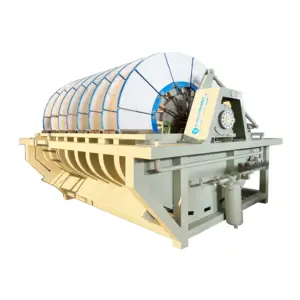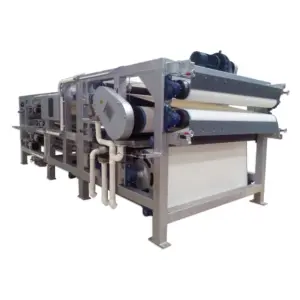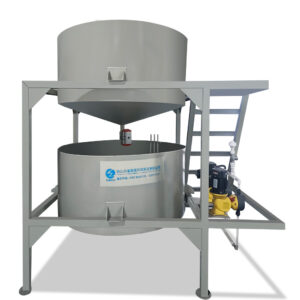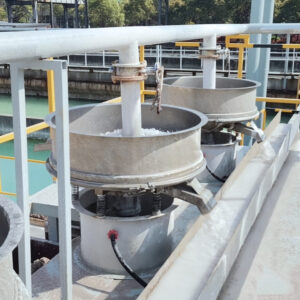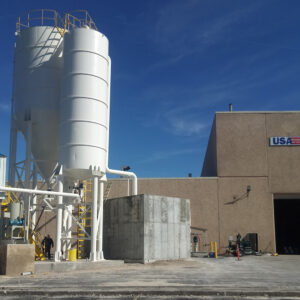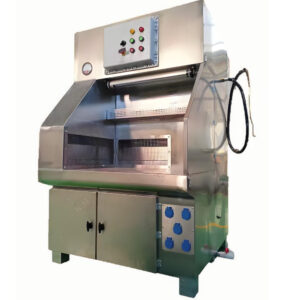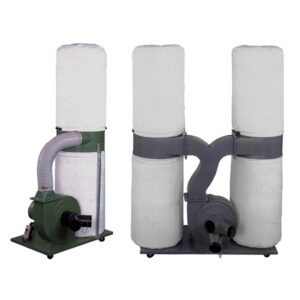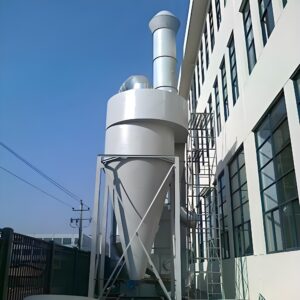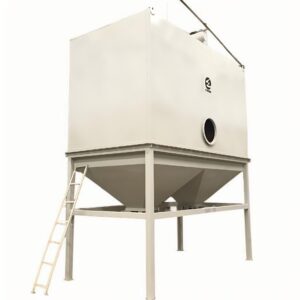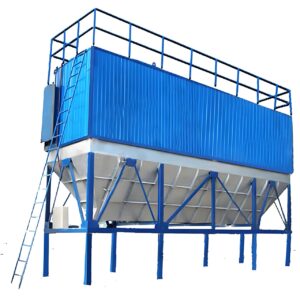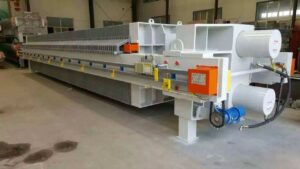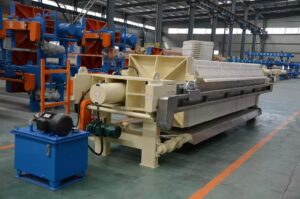The Fundamentals of Cyclone Dust Collection
Walk into any woodworking shop, manufacturing facility, or industrial processing plant, and you’ll likely encounter a familiar conical structure attached to the dust collection system. These elegantly simple yet remarkably effective devices are cyclone dust collectors, and they play a crucial role in maintaining air quality and equipment functionality across numerous industries.
The principle behind how cyclone dust collectors work is surprisingly straightforward, relying on fundamental physics rather than complex mechanisms. At their core, these systems harness centrifugal force to separate particulate matter from an air stream. When dust-laden air enters the cylindrical upper portion of the collector, it’s forced into a spinning vortex. As the air spirals downward through the conical section, the particulates, having greater mass than the air molecules, are flung outward against the cyclone walls due to centrifugal force.
The history of cyclone separation technology dates back to the late 19th century. The first cyclone separator was patented in 1885 by John M. Finch, though earlier versions had been used in flour mills. These early designs established the fundamental geometry that remains largely unchanged in modern systems. What has evolved significantly is our understanding of the fluid dynamics within these systems and the engineering precision applied to their design.
A standard industrial cyclone dust collector from PORVOO consists of several key components: an inlet duct, a cylindrical upper section (sometimes called the barrel), a conical lower section, a dust collection chamber or bin, and an outlet pipe. The inlet is typically positioned tangentially to the cylindrical section to initiate the circular motion of the incoming air. The outlet pipe, often called the vortex finder, extends down from the top center of the cyclone, allowing clean air to exit while preventing it from short-circuiting directly to the outlet.
What’s particularly interesting about cyclone collectors is that despite their apparent simplicity, their performance involves complex interactions between airflow patterns, particle characteristics, and geometric design. The seemingly minor details of a cyclone’s proportions—the diameter of the cylindrical section, the angle of the cone, the height of the vortex finder—can dramatically affect its collection efficiency and pressure drop characteristics.
One manufacturing plant manager I spoke with described cyclones as “deceptively simple,” noting that while anyone can build a cone that creates a vortex, engineering one that effectively captures specific particle sizes while maintaining reasonable energy consumption requires considerable expertise.
How Cyclone Dust Collectors Function: The Technical Process
To truly understand how cyclone dust collectors work, we need to examine the fluid dynamics and particle behavior occurring within these systems. When dust-laden air enters the cyclone through the tangential inlet, it immediately begins following a curved path along the inner wall of the cylindrical section. This initiates two distinct vortex patterns that form the foundation of the separation process.
The primary vortex forms as air spirals downward along the cyclone wall in what’s called a “forced vortex” pattern. As this spiraling air reaches the conical section, the decreasing diameter accelerates the rotational velocity—much like how a figure skater spins faster when pulling in their arms. This acceleration increases the centrifugal force acting on the particles suspended in the airstream.
Simultaneously, a secondary “free vortex” forms in the center of the cyclone, moving upward toward the outlet pipe. The interaction between these two vortices creates a complex flow pattern that enhances separation efficiency. Dr. James Anderson, an environmental engineering professor at MIT who specializes in particulate control technologies, explains: “The dual-vortex structure is what makes cyclones so effective. The outer vortex forces particles outward while the inner vortex creates a clean air core that exits through the vortex finder.”
The physics behind particle separation involves several forces acting simultaneously. The primary force driving separation is centrifugal force, which pushes particles outward toward the cyclone walls. Opposing this is the drag force from the airflow, which tries to keep particles suspended. The balance between these forces determines whether a particle will be captured or escape.
Particle size plays a crucial role in this balance. Larger, heavier particles experience greater centrifugal force relative to drag and are therefore more easily captured. As particles hit the cyclone wall, they lose momentum and slide down into the collection chamber. Very fine particles, particularly those below 10 microns, may have insufficient mass for centrifugal forces to overcome air drag, allowing them to escape with the clean air stream.
The industrial cyclone dust collector design has evolved to maximize this separation process. Modern cyclones achieve collection efficiencies exceeding 99% for particles larger than 10 microns, though efficiency drops significantly for smaller particles. Mathematical models developed since the 1950s, particularly the Lapple model and Barth equations, have helped engineers predict and optimize cyclone performance for specific applications.
During a recent facility tour at a furniture manufacturing plant, I observed the cyclone in action through a temporary inspection window installed for maintenance training. The violent spiraling motion within created a visible separation zone where larger sawdust particles were clearly being flung outward while the central air column remained remarkably clear—a powerful demonstration of the principles at work.
Types of Industrial Cyclone Dust Collectors
The evolution of cyclone technology has produced several distinct configurations, each designed to address specific operational requirements or space constraints. Understanding these variations helps in selecting the appropriate system for any given application.
The conventional single cyclone, often called a high-efficiency cyclone, represents the standard design used in many industrial applications. These units have a relatively narrow body with a long cone section, maximizing the path length along which particles travel and enhancing separation efficiency. They’re particularly suitable for medium to high volume airflow applications where moderate to high efficiency is required.
Multi-cyclone systems, sometimes called multiple tube cyclones, consist of numerous smaller cyclones arranged in parallel. By reducing the diameter of each individual cyclone, these systems achieve higher collection efficiencies for smaller particles. A manufacturing engineer I consulted with described it this way: “Think of it as dividing one large river into many small streams. Each small cyclone processes less air but does so more effectively for fine particles.” The trade-off is increased manufacturing complexity and higher pressure drop, which translates to greater energy consumption.
Compact cyclones, often called high-throughput or high-capacity cyclones, feature a wider body and shorter cone. While sacrificing some efficiency, particularly for smaller particles, these designs accommodate higher airflow rates with lower pressure drop. They’re often used as pre-cleaners in multi-stage filtration systems where removing the bulk of larger particulates protects downstream filters.
Axial-flow cyclones represent a variation where air enters from the top rather than tangentially. These designs are sometimes used in specialized applications or where space constraints make conventional cyclones impractical. However, they typically don’t match the efficiency of traditional tangential-inlet designs.
PORVOO’s cyclone dust collector range includes several innovative variations engineered for specific applications:
| Cyclone Type | Design Features | Optimal Application | Collection Efficiency |
|---|---|---|---|
| High-Efficiency Single Cyclone | Narrow body, extended cone | Woodworking, general manufacturing | 90-99% for particles >10μm |
| Multi-Clone System | Multiple small-diameter tubes | Metal grinding, fine powder processing | 85-95% for particles >5μm |
| Compact High-Capacity | Wider body, shortened cone | Pre-filtration, high-volume applications | 80-95% for particles >15μm |
| Specialized Abrasive-Resistant | Reinforced walls, replaceable wear plates | Mining, concrete processing | 85-98% for particles >10μm, with enhanced durability |
Each configuration presents distinct advantages depending on the specific requirements of the application. When a building materials manufacturer contacted me about excessive dust in their packaging area, we determined that a multi-cyclone system would be more appropriate than their existing single cyclone, despite the higher initial cost, because of the fine nature of their particulate.
Design Parameters and Performance Factors
The effectiveness of a cyclone dust collector hinges on several critical design parameters that must be carefully calibrated for each application. These factors determine not only collection efficiency but also pressure drop, which directly impacts energy consumption and operating costs.
Body diameter represents perhaps the most influential dimension. Smaller diameter cyclones generate stronger centrifugal forces at the same inlet velocity, improving collection efficiency for fine particles. However, this comes with a significant penalty in terms of pressure drop. According to calculations based on the Barth equation, reducing cyclone diameter by half while maintaining the same airflow can increase pressure drop by approximately four times.
Inlet dimensions and configuration significantly affect how particles enter the cyclone. The ideal inlet area typically ranges from 0.5 to 0.75 times the cross-sectional area of the cyclone body. Too large, and the inlet velocity drops, reducing separation efficiency; too small, and excessive pressure drop occurs. Most modern designs use rectangular inlets with height-to-width ratios between 1.5:1 and 2:1, creating an entry velocity profile that enhances the initial vortex formation.
The cone angle (typically between 10° and 30°) influences both separation efficiency and the ability to discharge collected material. Steeper cones accelerate the downward spiral more dramatically but may increase the likelihood of re-entrainment of particles. Sarah Chen, an industrial hygienist specializing in dust control systems, notes: “I’ve seen many facilities with improperly designed cone angles. A cone that’s too steep can create turbulence near the collection point, while one that’s too shallow fails to accelerate particles properly.”
The vortex finder (outlet tube) dimensions represent another critical design element. Its diameter and insertion length into the cyclone body significantly affect the formation of the inner vortex and the clean air core. Extending it too far down can disrupt the natural flow pattern, while an insufficient extension may allow “short-circuiting” of contaminated air.
These dimensional relationships create a complex optimization problem for engineers. The table below illustrates how these parameters interact and affect performance:
| Parameter | Effect of Increasing | Effect of Decreasing | Typical Range |
|---|---|---|---|
| Body Diameter | Lower pressure drop, decreased efficiency for fine particles | Higher pressure drop, improved fine particle collection | 6-60 inches depending on application |
| Cone Angle | Reduced pressure drop, potentially decreased efficiency | Increased pressure drop, potentially improved efficiency | 10°-30° from vertical |
| Inlet Velocity | Improved separation efficiency up to a point, then diminishing returns with higher pressure drop | Reduced separation efficiency, lower pressure drop | 2,500-4,500 ft/min |
| Vortex Finder Diameter | Reduced pressure drop, potentially decreased efficiency | Increased pressure drop, often improved efficiency | 0.4-0.6 × body diameter |
| Vortex Finder Length | Enhanced separation of fine particles, potential flow disruption if too long | Possible “short-circuiting” if too short | 0.5-1.5 × body diameter |
Material construction represents another crucial consideration. Depending on the application, cyclones may be constructed from mild steel, stainless steel, aluminum, or specialized abrasion-resistant alloys. For particularly abrasive applications, such as cement or mineral processing, internal wear protection like replaceable liners may be necessary.
When I consulted for a paper processing facility last year, we found their existing cyclones were underperforming because the inlet dimensions had been modified during a previous capacity upgrade. By restoring the proper inlet-to-body ratio specified in the original industrial cyclone dust collector design, collection efficiency improved by nearly 15% with only a modest increase in pressure drop.
Installation and Integration Considerations
The effectiveness of a cyclone dust collector extends beyond its inherent design to how it’s installed and integrated into the broader dust collection system. Improper installation can severely compromise performance, creating inefficiencies that persist throughout the system’s operational life.
System sizing represents the first critical decision. Undersized cyclones create excessive pressure drop and may allow dust to escape, while oversized units waste capital and occupy valuable floor space. The appropriate sizing depends on the required airflow volume, which must be sufficient to capture dust at its source while maintaining adequate transport velocity in the ductwork—typically 3,500-4,500 feet per minute for wood dust and 3,000-4,000 feet per minute for metal dust.
Ductwork design significantly impacts cyclone performance. Sharp bends, improper transitions, or incorrect duct sizes immediately before the cyclone inlet can disrupt the airflow pattern, compromising the formation of the proper vortex within the cyclone. I’ve observed installations where a poorly placed elbow just before the cyclone inlet reduced collection efficiency by as much as 20% due to the turbulent flow it created.
Proper support and anchoring is essential, particularly for larger units. Cyclones experience significant vibration during operation, and inadequate support structures can lead to fatigue failures at connection points. Additionally, the collection hopper or bin must be correctly sized and easily accessible for emptying.
The location of the cyclone relative to the dust source affects both performance and system economics. While placing the cyclone closer to the source reduces ductwork costs and pressure losses, it may necessitate multiple smaller units rather than a single centralized collector. During a recent manufacturing facility redesign, we opted for two strategically placed medium-sized cyclone dust collectors rather than one large central unit, resulting in a 15% reduction in overall system pressure drop despite the additional equipment cost.
Integration with existing ventilation or process systems requires careful planning. The table below outlines key considerations for different integration scenarios:
| Integration Scenario | Critical Considerations | Potential Challenges |
|---|---|---|
| New Installation | Optimum placement for dust capture, future expansion capacity, maintenance access | Balancing current needs with growth potential, coordination with other building systems |
| Retrofit to Existing System | Compatibility with existing ductwork, potential reinforcement of support structures, pressure drop impacts on existing fans | Space constraints, maintaining operations during installation, potential need for additional fan capacity |
| Addition to Multi-Stage System | Proper sequencing of filtration stages, pressure drop allocation across system | Ensuring proper transition between stages, preventing overloading of downstream filters |
| Outdoor Installation | Weather protection, condensation prevention, freeze protection for discharge mechanisms | Insulation requirements, additional structural support for wind loads |
Discharge handling merits particular attention, as the collected material must be efficiently removed to prevent re-entrainment or system blockage. Options range from simple collection drums to automatic airlocks and screw conveyors for continuous operation. The choice depends on factors including material volume, characteristics, and facility operational patterns.
One woodworking shop I visited had installed a properly sized cyclone but used an undersized collection bin that required emptying every two hours, creating a workflow disruption and occasionally leading to overflow conditions that contaminated the workshop. By switching to an appropriate collection system with level indicators, they eliminated these issues entirely.
Maintenance and Troubleshooting
Even the most perfectly designed and installed cyclone dust collector requires proper maintenance to maintain optimal performance over time. Neglected maintenance not only reduces collection efficiency but can lead to system failures, increased energy consumption, and potentially hazardous conditions.
Regular inspection constitutes the foundation of any maintenance program. Key areas to examine include the inlet for wear or material buildup, the cone section for potential abrasion or damage, and the dust discharge mechanism for proper functioning. A maintenance manager at a furniture manufacturing facility shared: “We instituted a monthly inspection regime after discovering severe abrasion in a cyclone cone that had been operating for years without inspection. Catching wear patterns early allowed us to schedule repairs during planned downtime rather than dealing with emergency failures.”
Common maintenance procedures for cyclone collectors include:
- Checking and cleaning the inlet area to prevent flow restrictions
- Inspecting the cyclone body for wear, particularly at areas of flow direction change
- Ensuring the dust discharge mechanism operates properly without leakage
- Verifying that collection containers or conveyors are functioning correctly
- Checking fasteners and supports for loosening due to vibration
- Examining ductwork connections for leaks that could compromise system pressure
While cyclones have fewer moving parts than many alternative dust collection technologies, they’re not immune to performance issues. Several indicators may signal inefficient operation, including excessive dust in the exhaust air, unusual noise or vibration, increased pressure drop across the system, or buildup of material in areas designed to remain clear.
When troubleshooting cyclone performance problems, a systematic approach works best. The table below presents common issues, potential causes, and remedial actions:
| Problem | Possible Causes | Recommended Actions |
|---|---|---|
| Reduced Collection Efficiency | Improper inlet velocity, wear in cyclone body, leaks in the system | Check fan performance, inspect for wear or damage, pressure test for leaks |
| Excessive Pressure Drop | Material buildup, improper fan selection, restrictions in ductwork | Clean internal surfaces, verify fan curve matches system requirements, inspect ducts for blockages |
| Dust Re-entrainment | Overfilled collection container, improper discharge mechanism, turbulence in collection area | Implement level monitoring, repair/replace discharge components, modify discharge area to reduce turbulence |
| Material Buildup on Walls | Sticky or hygroscopic material, insufficient wall steepness, static electricity | Consider surface treatments, evaluate material properties, implement cleaning protocols, consider antistatic measures |
| Irregular or Excessive Noise | Imbalance in rotating components, loose connections, foreign objects, improper airflow | Balance fan, tighten connections, inspect for debris, verify system design parameters |
The longevity of a cyclone system can be significantly extended through preventative maintenance. In abrasive applications, installing wear indicators or thickness testing points allows early detection of thinning walls before perforation occurs. For applications involving potentially sticky materials, access doors at strategic locations facilitate periodic cleaning.
During a consultation at a plastics processing facility, we discovered their industrial cyclone dust collector was operating at only 60% of its rated efficiency. Investigation revealed that fine plastic powder had built up on the interior walls over years of operation, altering the effective dimensions of the cyclone and disrupting the airflow pattern. After a thorough cleaning and implementation of a regular maintenance schedule, efficiency returned to design specifications, and energy consumption decreased by approximately 15%.
Applications Across Industries
The versatility of cyclone dust collectors makes them valuable across an impressive range of industries, each with unique dust characteristics and collection requirements. Understanding these applications illustrates the adaptability of cyclonic separation technology.
In woodworking and furniture manufacturing, cyclones excel at capturing the mixture of coarse and fine particles generated by cutting, sanding, and shaping operations. The relatively low density of wood particles makes them ideal candidates for cyclonic separation. Cabinet shops particularly benefit from cyclones as pre-separators before baghouse filters, extending filter life dramatically by removing the majority of larger chips and dust. During a visit to a custom furniture workshop, the owner demonstrated how their cyclone captured over 95% of the material by weight before it reached the secondary filter, reducing maintenance costs substantially.
Metal processing industries utilize cyclones for collecting heavier particles from grinding, cutting, and blasting operations. The higher density of metal particles increases separation efficiency, though the abrasive nature of these materials necessitates more robust construction. One machine shop I consulted with had installed wear-resistant liners in high-impact areas of their cyclone, extending the service life from approximately 2 years to over 5 years despite processing abrasive cast iron dust.
Food processing presents unique challenges due to product purity requirements and potential combustibility of many food dusts. Cyclones in these applications are often constructed of stainless steel with smooth, easy-to-clean surfaces. They’re particularly valuable in grain handling, flour milling, and sugar processing, where they can handle the high volumes of dust generated while minimizing explosion risks through continual dust removal.
In pharmaceutical manufacturing, cyclones often serve as the first stage in multi-level containment systems for active pharmaceutical ingredients (APIs). The ability to collect and contain valuable or potent compounds makes them economically important beyond their dust control function. One pharmaceutical engineer noted: “Our cyclone system recovers approximately 98.5% of product that would otherwise be lost to the filtration system, representing significant value recovery.”
Mining and mineral processing operations leverage cyclones for their ability to handle abrasive materials at high throughput rates. These applications typically employ cyclones with specialized wear-resistant materials or replaceable liners. The collection of valuable mineral dusts can actually represent a profit center rather than merely a compliance requirement.
Chemical processing industries utilize cyclones for collecting catalysts, intermediate products, and various chemical compounds. The inert construction materials available for cyclones make them suitable for corrosive or reactive environments where other collection technologies might be compromised.
Cement and concrete production facilities employ heavy-duty cyclones to capture the coarse, abrasive dusts generated during crushing, grinding, and mixing. These applications require exceptionally robust construction and often feature knock-down designs that allow for easy replacement of wear components.
The agriculture sector uses cyclones for grain dust collection in elevators and processing facilities. Their effectiveness with organic particulates and relatively simple maintenance requirements make them well-suited to rural applications where technical support may be limited.
Across these diverse applications, the industrial cyclone dust collector technology demonstrates remarkable adaptability through variations in materials of construction, geometric configurations, and integration options. This flexibility, combined with their inherent reliability, explains why cyclones remain a cornerstone of industrial dust collection despite being one of the older technologies in the field.
Comparing Cyclone Technology with Alternative Dust Collection Methods
To fully appreciate the role of cyclone dust collectors in modern industry, we should examine how they compare with alternative dust collection technologies. Each approach offers distinct advantages and limitations that make them more or less suitable for specific applications.
Baghouse filters capture particles as dust-laden air passes through fabric filter media. Unlike cyclones, which rely on inertial separation, baghouses can capture much finer particles—often down to sub-micron sizes. However, this enhanced filtration comes with higher initial cost, more complex maintenance requirements, and typically greater pressure drop. When I toured a metal fabrication facility transitioning from baghouses to a hybrid system, the maintenance manager explained: “We were changing bags every few months at significant cost. By installing a cyclone pre-separator, we’ve extended bag life to over a year while reducing our overall pressure drop.”
Cartridge collectors represent an evolution of baghouse technology, using pleated filter elements to increase surface area. They offer excellent fine particle capture but share many limitations with baghouses, including higher pressure drop and maintenance requirements. They’re particularly vulnerable to damage from larger particles or high dust concentrations—exactly the conditions where cyclones excel as pre-filters.
Wet scrubbers capture dust by forcing particles to contact liquid droplets, which are then separated from the airstream. They can handle high temperatures and some combustible dusts better than dry methods but introduce water handling and treatment requirements. The hybrid approach of using a cyclone followed by a wet scrubber often provides an optimal solution for high-temperature applications with mixed particle sizes.
Electrostatic precipitators (ESPs) use electrical charges to separate particles from airstreams. They offer very low pressure drop and can capture extremely fine particles, but they involve higher capital costs, require significant space, and may pose safety concerns with certain combustible dusts. The comparison table below highlights key differences between these technologies:
| Technology | Particle Size Range | Typical Efficiency | Pressure Drop | Maintenance Requirements | Relative Capital Cost | Best Applications |
|---|---|---|---|---|---|---|
| Cyclone | 10μm and larger | 70-90% | Low to moderate | Low – primarily inspection | Low | Pre-filtering, larger particles, abrasive dusts |
| Baghouse | 0.5-50μm | 99%+ | Moderate to high | High – filter replacement, cleaning systems | Moderate | Fine particles, high efficiency needs, temperature-sensitive materials |
| Cartridge Collector | 0.3-50μm | 99.9%+ | Moderate to high | High – filter replacement, compressed air | Moderate to high | Very fine particles, limited space applications |
| Wet Scrubber | 1-100μm | 90-98% | Moderate | Moderate – water treatment, nozzle maintenance | Moderate | Hot gases, sticky materials, fire risks |
| Electrostatic Precipitator | 0.05-50μm | 95-99% | Very low | Moderate – electrode cleaning | High | Very low pressure drop requirements, extremely fine particles |
The optimal approach often involves combining technologies to leverage their complementary strengths. Cyclones frequently serve as pre-cleaners, removing the majority of larger particles before the airstream reaches more efficient (but more sensitive and expensive) secondary filtration systems. This arrangement extends the life of secondary filters while maintaining high overall collection efficiency.
Energy consumption represents a critical factor in technology selection. While cyclones may not match the filtration efficiency of baghouses or cartridge collectors for fine particles, their lower pressure drop translates directly to reduced fan power requirements. For applications where most particles are larger than 10 microns, a standalone cyclone often provides the most economical solution from both capital and operating cost perspectives.
Maintenance requirements also factor heavily into technology selection. Cyclones require minimal maintenance beyond regular inspection and occasional cleaning, with few or no consumable components. This makes them particularly suitable for remote locations or facilities with limited maintenance resources.
During a recent project evaluating dust collection options for a ceramics manufacturer, we ultimately recommended a high-efficiency cyclone dust collector despite its lower theoretical efficiency compared to a baghouse. The abrasive nature of the ceramic dust would have necessitated frequent bag replacements, while the cyclone’s robust construction and lack of filter media provided a more practical long-term solution. The resulting system has operated for over two years with minimal maintenance while meeting all applicable emission requirements.
The Future of Cyclone Dust Collection
Despite being one of the oldest dust collection technologies, cyclone separators continue to evolve through advances in computational fluid dynamics, materials science, and manufacturing techniques. These developments are extending the applications and improving the performance of cyclone technology in several notable ways.
Computer-aided design and computational fluid dynamics (CFD) have transformed cyclone design from an empirical art to a precise science. Engineers can now model complex airflow patterns and particle trajectories with remarkable accuracy, optimizing geometries for specific applications. A PORVOO engineering team lead explained during a technical seminar: “We’ve reduced development cycles by 70% while improving collection efficiency by using advanced CFD models to test design iterations virtually before building prototypes.”
These computational advances have led to novel cyclone geometries that outperform traditional designs for specific applications. Innovations include adjustable inlet vanes that optimize tangential velocity based on airflow, dual-vortex designs with enhanced separation zones, and modular components that can be reconfigured as process requirements change.
Material science advancements are addressing wear issues in abrasive applications. New ceramic composites, advanced polymer linings, and specialized metal alloys can extend service life by factors of three to five compared to conventional materials. These developments make cyclones increasingly competitive in applications previously considered too abrasive for practical implementation.
Integration with digital monitoring systems represents another frontier. Modern cyclones increasingly incorporate pressure differential sensors, optical density monitors for outlet air, and vibration monitors that detect developing issues before they become critical. These systems can automatically adjust fan speeds or cleaning cycles to maintain optimal performance as conditions change.
Environmental regulations continue to drive innovation in dust collection across all technologies. As permissible exposure limits decrease for many substances, hybrid systems combining cyclones with other technologies will likely become more common, leveraging the strengths of each approach while compensating for their limitations.
The fundamental physics of cyclonic separation ensures that this technology will remain relevant well into the future. As one senior environmental engineer put it during an industry conference: “When you need a solution that’s robust, reliable, and energy-efficient for larger particles, it’s hard to improve on the cyclone concept. We’re not reinventing the principle—we’re just making it work better through improved materials, precision manufacturing, and sophisticated controls.”
For industries dealing with dust collection challenges, the message is clear: cyclone technology continues to offer compelling advantages in many applications, particularly as part of a thoughtfully designed overall dust management strategy. The continued refinement of this seemingly simple technology demonstrates that sometimes the most enduring solutions are built on fundamental principles executed with increasing precision and understanding.
Frequently Asked Questions of how do cyclone dust collectors work
Q: What is a cyclone dust collector, and how does it function?
A: A cyclone dust collector, also known as a cyclone separator, is a device that removes particulate matter from air or gas streams. It works by using centrifugal force to separate heavier dust particles from the air, directing them towards the outer walls of a cylindrical chamber, where they settle and are collected at the bottom.
Q: How do cyclone dust collectors use centrifugal force?
A: Cyclone dust collectors utilize centrifugal force by spinning the air-dust mixture in a circular path. As the mixture enters the cyclone, it is forced to spin rapidly, causing heavier particles to be flung towards the walls due to centrifugal force. The lighter particles continue to the center and are expelled through the top outlet.
Q: What benefits do cyclone dust collectors offer in industrial settings?
A: Cyclone dust collectors offer several benefits in industrial settings:
- Efficiency: They remove large and heavy particles, reducing the load on downstream filtration systems.
- Extended Filter Life: By capturing larger dust particles, cyclones extend the lifespan of filters, reducing maintenance needs.
- Cost-Effective: They minimize the need for frequent filter cleaning and replacement.
Q: Can cyclone dust collectors remove all dust particles?
A: While cyclone dust collectors are effective at removing larger particles (>10 microns), they are less effective for very fine dust particles (<2.5 microns), which often bypass the cyclone and require additional filtration to be captured.
Q: How do cyclone dust collectors compare to other dust collection methods?
A: Cyclone dust collectors are particularly useful for removing larger particles compared to other methods like filters or electrostatic precipitators. They are often used in combination with these systems to enhance overall efficiency by pre-filtering coarse particles.
Q: Are there different types of cyclone dust collectors?
A: Yes, there are different types of cyclone dust collectors, including single-cyclone, multiple-cyclone, high-efficiency, and reverse-flow cyclones. Each type is designed for specific applications and efficiency requirements.
External Resources
- How Does a Cyclone Dust Collector Work? – This resource explains the operation of cyclone dust collectors, highlighting their principle of centrifugal force and application as pre-cleaners in dust collection systems.
- Understanding Cyclone Dust Collectors – Offers insights into the operating principles, design specifications, and costs associated with cyclone dust collectors, focusing on their efficiency and industrial applications.
- How Does a Cyclone Dust Separator Work? – Provides details on how cyclone dust separators function using centrifugal, gravitational, and inertial forces to remove dust from air streams efficiently.
- How Cyclone Dust Collectors Work – Explains the process of dust separation using centrifugal force and highlights their effectiveness in workshop environments to reduce filter maintenance.
- How a Cyclone Dust Separator Works – Although not a direct match, this video provides visual explanations and practical examples of cyclone separator functionality, emphasizing their role in keeping filters clean.
- Cyclone Separators: Basics and Design – Focuses on the fundamental design principles and applications of cyclone separators, providing technical insights into their operation and efficiency.
